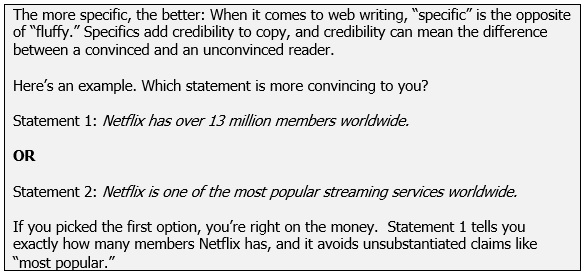
Five Common Web Writing Mistakes to Avoid
FIVE COMMON WEB WRITING MISTAKES TO AVOID
Web copy can be tricky to master: It has to sell, but it can’t feel too salesy. It has to be packed with useful, relevant information, but it needs to be succinct and easy to scan. It has to differentiate your company, product, or service — but at the same time, it can’t feel like it’s “all about you.”
We’ve found that there are a few common web writing mistakes that come up again and again with web copy. In this post, we’ll explore five of the most common ones — and share our strategies for avoiding them.
- Mistake 1: Ignoring navigation
It’s tempting to treat content and layout as two separate things, but we’ve found that the most effective websites begin with an integrated approach. When you have a solid grasp of your site’s navigation and layout, you’re better equipped to write content that fits into that navigation in an intuitive, seamless way.
A few questions to consider:
How will visitors navigate your site?
What information will they be looking for on each page?
How can you ensure that visitors can find what they need easily?
Will your most important copy points appear “above the fold”?
Can you use design elements like callout boxes and sidebars to highlight key points?
Is your copy broken up in a logical way?
Do you have too many pages? Too few pages?
What action do you want people to take after scanning the page? - Mistake 2: Super-long copy
Good web writing should tell your customers what they want to know in the first two sentences. Remember, website visitors come to a site to gather information. If they have to read paragraphs of unnecessary fluff to get to the “meat” of your product or service, they’ll probably move on.
Here’s an example:
“You need a car to get you to work. You need a car to take your kids to school, for trips to the grocery store, and for epic road trip adventures. You need a car to live your life – but you don’t need to pay top dollar for it. That’s why Two Brothers Used Cars specializes in certified pre-owned vehicles – guaranteed to save you money.”
The above paragraph is long and meandering, and it wastes valuable real estate stating the obvious: Your readers already know why they need a used car. They want to know why they should buy a used car from Two Brothers Used Cars.
Here’s a better option:
“Two Brothers Used Auto has thousands of pre-owned vehicles at wholesale prices. Reliable. Affordable. And all used cars come with a year-long free maintenance package. Come take a test drive today.”
Our advice: Resist the urge to “ease” in to your copy. Jump in, be bold, and get right to the point — your readers will appreciate it! - Mistake 3: The “Wall of text”
People read differently on a screen than they do on a printed page – their eyes flit around the page, scanning for information. Copy that appears too dense — also known as the dreaded “wall of text” can be a turnoff.
In fact, if your web copy looks too dense, readers will likely give up and move on.
Here are some ways to break down those “walls” and make your copy more scannable and web-friendly:
Use bullets to highlight important points.
Use bolded headers.
Break up paragraphs (limit each paragraph to three to five sentences, max)
Use visuals like infographics, tables, or photos
Use callout boxes and sidebars to highlight information
Use lots of white space
Insert links to relevant pages - Mistake 4: Wordiness and fluff
One way to keep web copy succinct: Avoid filler fluff and unnecessary words. Some hard-nosed editing can help streamline your copy. Scan your draft with these questions in mind:
Is there a single, better word that you can substitute for two words? For example, you could use “boring” instead of “not interesting.” You could use “to” instead of the wordier “in order to.”
Can you eliminate any fluffy, meaningless phrases? Don’t tell readers that your sales team is “committed to excellence” or “dedicated to success.” It’s much better to say something meaningful, like the fact that your sales team has a combined three decades of experience or has completed hundreds of hours of advanced training.
- Mistake 5: Showcasing features, not benefits
Emphasizing the benefits of your product or service is more important than emphasizing features – that’s because benefits persuade, features only inform. Benefits are relevant to customers, features aren’t.
For example, let’s say your company sells high-end wristwatches: Details like “illuminated dial,” “digital alarm,” and “solar-powered battery” are features. But why should a potential customer care? This is where the benefits come in: The illuminated dial means you can tell the time in the dark. The solar power means that you never have to replace a battery. The digital alarm means that it can pull double duty as an alarm clock or a stopwatch.
Related Content
- 0 Comment
Subscribe to Newsletter
- How Can SharePoint Be Used To Organize and Disseminate SOPs?
- Planning the Perfect Genealogy Research Trip: A Step-by-Step Guide
- From Silly to Awesome: How Words Change Meaning Over Time
- The Psychology of Font Choice: How Typography Impacts Content Engagement
- How to Distribute SOPs for Maximum Usability




